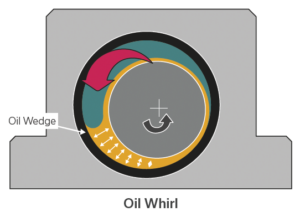Costly repairs and downtime could have been avoided
There are several instances during our day-to-day routines that we notice something out of place, or in some cases just plain wrong. In the case of one Military Sealift Command T-AE class ships, the crew noticed the No. 1 Ships Service Turbine Generator (SSTG) intermittently inducing noticeable vibration throughout the engine room.
Crew instinct and their investigation indicated something was wrong with the No. 1 SSTG; but the cause was unknown. The challenge for the crew was the abnormal vibration was intermittent and developed and disappeared at random with no degraded SSTG performance or abnormal internal conditions (such as lube oil temperatures and pressures).
During a follow-on machine inspection, SymphonyAI Industrial performed vibration tests to determine and isolate the offending vibration symptoms. Several test cycles were conducted, testing all three onboard SSTGs in a variety of conditions: off-bus, loaded/in-parallel operation, loaded/isolated, while underway and at anchor. Results revealed a serious but randomly occurring condition in the No. 1 SSTG turbine bearings known as oil whirl.
Oil whirl is characterized by an unstable oil wedge in the journal bearing, due to either to excessive clearances, defect in the bearing or improper lubrication. Normally a rotating shaft is suspended on an oil film and has a stable elliptical orbit in the journal bearing. However with oil whirl, the shaft is forced into a chaotic gyration path creating the potential for metal to metal contact. This phenomenon develops excessive horizontal and vertical vibration amplitudes between 0.38 times and 0.49 times shaft rotation speed.
A similar and more critical condition known has “oil whip” can occur when the critical speed (natural frequency) of the machine and oil whirl combine to cause destructive forces within the bearing/machine.
In this case, testing identified the offending vibration as originating from the No. 1 SSTG turbine bearings. The oil whirl condition was indicated by excessive vibration at 0.49 times and 1.49 times the turbine shaft rotation speed. Journal bearing readings from the SSTGs No. 2 and 3 did not exhibit any of these vibration characteristics. This was the “smoking gun”.
An oil whirl condition in a machine is serious and the unit should not be run except when absolutely necessary. The recommended repair and maintenance action is to inspect the turbine journal bearings. Specifically verify: proper bearing lubrication, proper bearing temperature and oil pressure, proper mechanical bearing fit in the housing and proper bearing clearances (tolerances) according to the bearing manufacturers specifications.
Unfortunately due to ship operating requirements, the unit could not be taken off line to perform the bearing inspection. This unit failed 3 months later. The turbine bearings wiped and required extensive repair work, repair cost and ship down time in the repair yard.
About SymphonyAI
SymphonyAI is building the leading enterprise AI company for digital transformation across the most important and resilient growth verticals, including retail, consumer packaged goods, finance, manufacturing, media, and IT service management. SymphonyAI verticals have many leading enterprises as clients. Since its founding in 2017, SymphonyAI has grown rapidly to 2,000 talented leaders, data scientists, and other professionals. SymphonyAI is an SAIGroup company, backed by a $1 billion commitment from Dr. Romesh Wadhwani, a successful entrepreneur and philanthropist.


